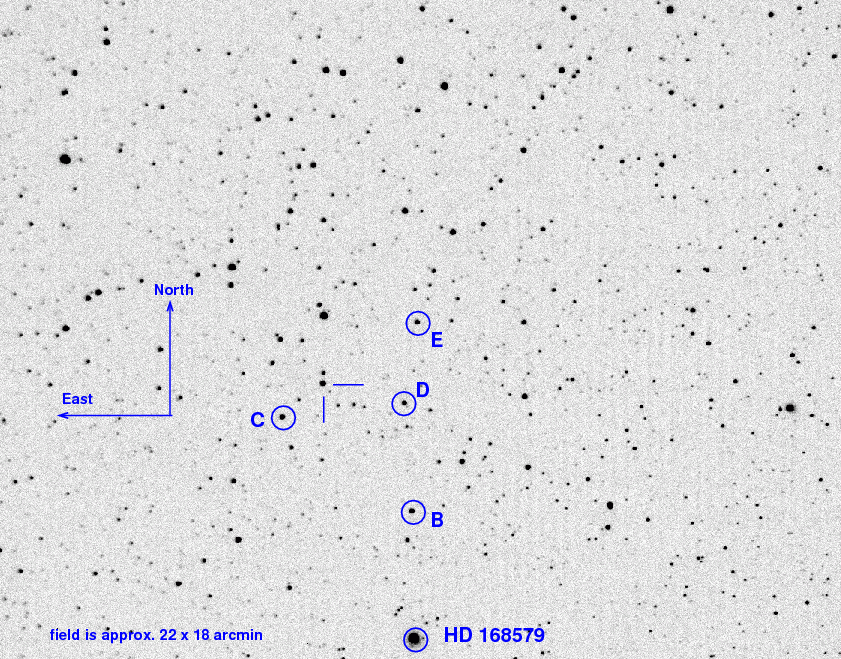
On the night of Jun 07/08, 2018, from about 11:45 to dawn, through pretty cloudy skies, I acquired a set of observations of the likely black-hole system MAXIJ1820+070, (also known as ASASSN-18ey ).
The main setup was:
Notes from the night:
This optical and X-ray and radio transient is likely a black hole accreting material at a higher-than-usual rate. It has been the subject of many observers over the past few months -- see the trail of telegrams that include
The object is located at
RA = 18:20:21.9 Dec = +07:11:07.3
A chart of the field is shown below. The size of the chart is about 22 by 18 arcminutes.
I've marked the location of several comparison stars, which also appear in light curves below. Stars C, D, and E are mentioned by the Tomoe Gozen team in ATel 11426, but all three are rather red, with (B-V) ranging from 1.14 to 1.37. Star B is one of the bluest nearby bright stars, with (B-V) = 0.52.
star UCAC4 B V ---------------------------------------------------- B 486-079513 12.975 12.454 C 486-079608 13.968 12.830 D 486-079523 14.637 13.272 E 487-077858 14.637 13.272 ----------------------------------------------------
The dark current was pretty ordinary.

The sky value shows clouds coming and going all night long. Bleah.

Here's a record of the telescope's drift. Note little Dec drift early, when the field was near the Eastern horizon; that means the altitude is close to correct. But there's a big Dec drift as the field crosses the meridian around 277.80, which means that the AZIMUTH position needs to be adjusted. The notes from UT 2018 May 19 suggest that I'll need to turn the azimuth knob CCW to fix it.
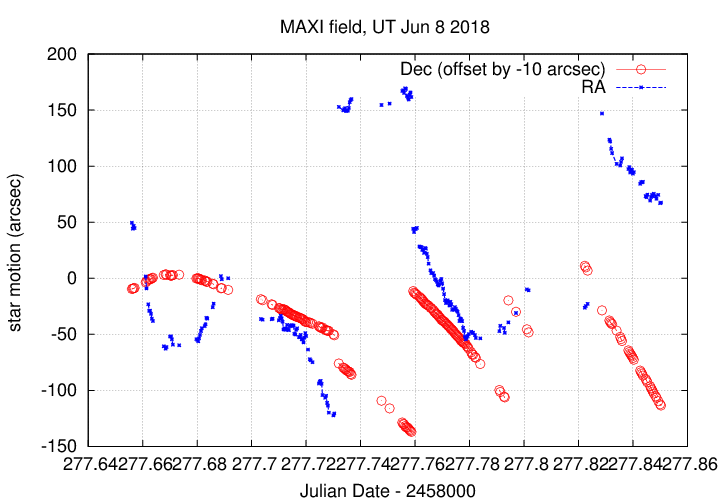
The number of objects detected -- I required 50 objects for an image to be included in the ensemble.
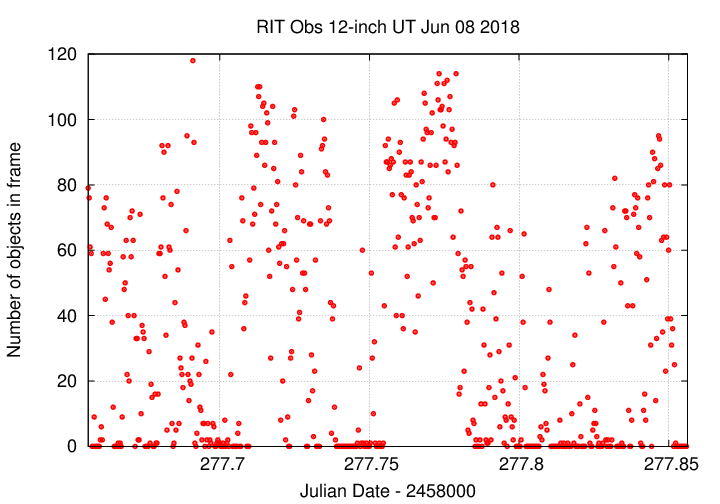
I used an aperture with radius 5.0 pixels.

Image adjustment factor shows lots of clouds, all the time. More than half of the images were removed from the analysis.

Using aperture photometry with a radius of 5 pixels (binned 2x2, each pixel is 1.34 arcsec, so a radius of 6.7 arcsec), I measured the instrumental magnitudes of a number of reference stars and the target. Following the procedures outlined by Kent Honeycutt's article on inhomogeneous ensemble photometry, I used all stars available in each image to define a reference frame, and measured each star against this frame.
Sigma-vs-mag plots show that the floor was about 0.008 mag overall. The outlier around instrumental magnitude 2.8 is MAXI J1820+070.
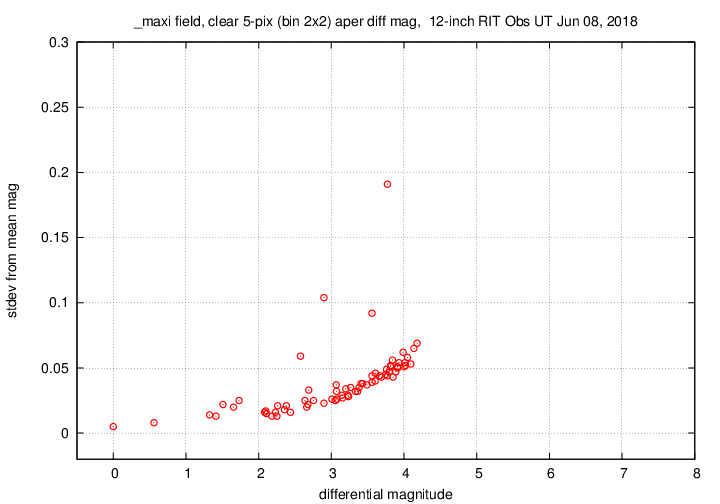
Here are light curves of the variable and the field stars.
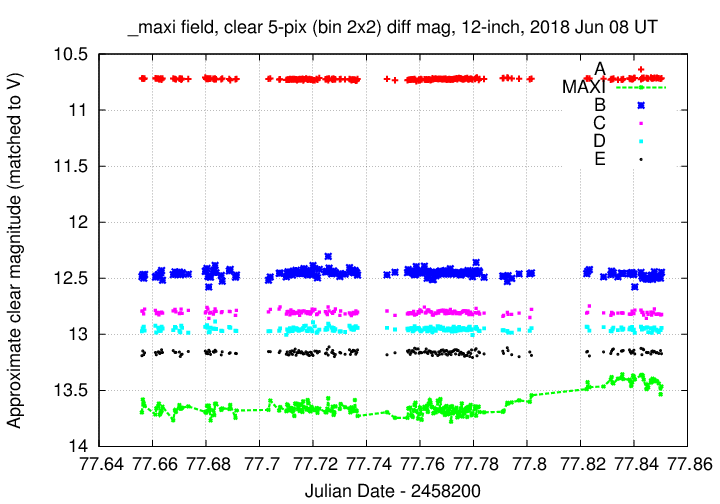
I used the UCAC value for the V-band magnitude of star "B" = UCAC4 486-079513 to shift the ensemble magnitudes to the standard V-band scale -- but remember that these are UNFILTERED measurements.
Here's a closeup on the variable. I'll connect the dots to make its behavior a bit easier to see.
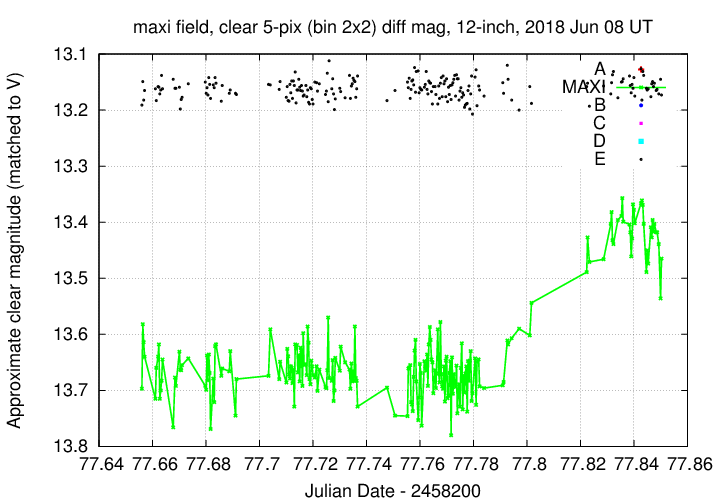
You can download my measurements below. A copy of the header of the file is shown to explain the format.
# Measurements of MAXIJ1820+070 made at RIT Obs, UT 2018 Jun 8, # in poor conditions, # by Michael Richmond, # using Meade 12-inch LX200 and ATIK 11000. # Exposures 25 seconds long, no filter. # Tabulated times are midexposure (FITS header time - half exposure length) # and accurate only to +/- 1 second (??). # 'mag' is a differential magnitude based on ensemble photometry # using a circular aperture of radius 5 pix = 6.6 arcseconds. # which has been shifted so UCAC4 486-079513 has mag=12.454 # which is its V-band magnitude according to UCAC4. # # UT_day JD HJD mag uncert Jun08.15605 2458277.65605 2458277.66083 13.697 0.030 Jun08.15639 2458277.65639 2458277.66117 13.582 0.028 Jun08.15670 2458277.65670 2458277.66148 13.614 0.026
Last modified 6/08/2018 by MWR.